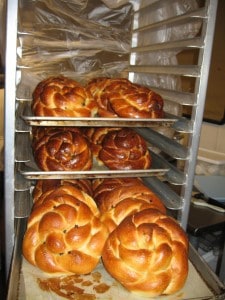Hosting a Shabbat meal is a wonderful way to spend quality time with family and friends without the distractions of the everyday (email, ringing cell phones, distracting smartphone messages…). It also offers an amazing template over which to create rituals and traditions that add new meaning and sustainable flair to the experience. Hazon offers the following resources to help you Green Your Shabbat and discover, “What makes this Shabbat meal different from other Shabbat meals?”
Activities & Rituals
Involve your friends.
Don’t take on the local kavannah alone – get your friends involved! If no farmer’s market is readily available at which you/your guests can buy local produce, what other criteria can you use for buying locally or sustainably? Perhaps everyone will pledge to use no plastic bags in their shopping (including those little bags for vegetables and fruit!) or to bike to their supermarkets instead of hopping in a cab with an armload of groceries. ChicoBag is a great resource to find reusable bags, especially made for produce.
Potluck
Involve your friends in more than the “no plastic bag” pledge, encourage them to create their own dishes and bring them over!
Utilize peoples’ skills
Maybe someone is a great baker—ask him to make challah. Someone else might have a knack for roasting her own peppers or making fruit preserves—find a way to use that as well! Don’t feel afraid of using people’s skills to lead the blessings either! If friends and family at the table feel more comfortable with certain blessings, empower those at the table to share the blessings and take leadership of the ones most familiar and meaningful to them.

Take a Food Tour
Invite friends and family into the conversation about where ingredients for your shared meal will come from. Take a few minutes before, during, or after your meal to go around and have each person explain what is on their plate, where it came from, and who helped to get it to your plate!
Family Partnership
If multiple family trees are present at your Shabbat Table, it is nice to involve each other in trading family traditions, culture, ways that Shabbat has been celebrated in the past, and ways you might like to celebrate it in the future. Learning from each others families is exciting, interesting, and an easy way to bring meaningful, new traditions of which you have witnessed the origins, at future Shabbat tables.
Bless your meal together
Other than the traditional brachot (blessings), birkat hamazon (grace after meals), invite your guests to discuss whom they want to thank before, during, and following this unique meal and encourage them to create their own blessings or songs if they so choose.
Eat together
With intention. In silence. Try spending the first 10 minutes of your meal just enjoying the food and company without speaking. It might feel a little strange at first, but see if you can relax into the idea. And of course you can share your experiences afterwards!
Learn together
Identify a learning coordinator for your meal who will come up with questions to lead the discussion around the table, and identify short texts that can be learned together.
Discussion Starter Examples:
- “What does sustainable mean to you?”
- “How is your relationship to this meal different from other meals knowing how it was prepared and where the ingredients were purchased?”
- “What is the connection between Shabbat and having a sustainable meal?”
Texts are another great way to create an order and guide your meal. Here are some examples:
- Hazon’s book “Food for Thought” curriculum book is an incredible resource for relevant texts!
- Highlights from Michael Pollan’s The Omnivore’s Dilemma
- Barbara Kingsolver’s Animal, Vegetable, Miracle
An Activity for Your Classroom

In today’s world, we are often ignorant of the many steps and people involved in bringing food to our table. In the consciousness of many children (and adults too), flour is something that comes from the grocery store in a bag with a knight on it, and challah magically appears on the Shabbat table each week. This short activity helps to bridge that gap in our mind and illustrate the process to make challah, from the soil to your mouth.
Download this set of 16 cards, and ask your students to put them in order, whether by taping them on the wall, or standing in a line and moving around (it is even more fun if you challenge them to do it silently!).
After successfully completing the exercise, ask questions such as:
- Were there any parts of the process that surprised you?
- Were there any parts of the process that you had never heard of before?
- What are some ways that we can be mindful about the process that it takes to get all of our food from the farm to our forks?
Share Your Stories
Have you used the Soil to Challah activity in your community? Did you have a great conversation or did it inspire you to take action? Send an email to foodeducation@hazon.org with your story and you could be featured in an upcoming blog post.
Brachot Cards Answer Key
Here is the correct order for the cards:
- Soil
- Plow
- Sow – plant your seeds
- Water, weed, and tend your seeds so they grow into wheat sheaves
- Reap – cut down and gather wheat sheaves
- Thresh – cleaning process to remove stalks and leave just the wheat kernels
- Winnow – separate the wheat grains from the husks
- Grind – break the wheat kernels into tiny pieces for flour
- Yeast & Water- making the dough
- Knead
- Rise
- Bless- separating, burning and blessing a piece of dough before baking
- Bake dough
- Challah
- Bless- blessing before eating
- Eat
Foods & Recipes
Part of greening your Shabbat table involves paying attention to eating seasonally. Here are recipes for each season that will help you to keep the food at your Shabbat table sustainable, healthy, and delicious too!
Summer
Fall
Winter
Spring
Sustainability Tips
Go Local

Set a kavvanah (special intention) to “go local.” Whether you decide to make all your dishes from scratch, or purchase some things ready-made, make a pledge to feature ingredients and dishes that are locally grown. Remember that the definition of “local” is loosely defined – so decide in advance where you want to draw the boundary. Even if you don’t manage to eat all local, all the time in you
r day-to-day life (and really, who does?), Shabbat is the perfect time to strive for that ideal. See just how local you can go!
Local Produce
Getting your produce from a local farmers market, food co-op, or CSA, are all great ways to bring local produce directly to your Shabbat table. This gives you the opportunity to celebrate Shabbat with a healthy festive feeling, and a means for bonding with the community surrounding you over the plentiful benefits of sustainable local food!
Kosher Sustainable Food Options
Wine…
If you are comfortable drinking non-kosher wine, try to find a bottle (or box) of wine grown and produced close to home. If you prefer kosher, check out this kosher organic wine list. The Jew and the Carrot has a great article on what wines to pair with your Shabbat meal!
Meat…
Recent scandals in the kosher meat world have led many to reconsider what kosher meat really means. While we might have at one time assumed that kosher meat was healthier and more sustainable, in fact most kosher meat is raised the same as conventional non-kosher meat. However, a small number of crusaders have launched companies to make sustainably raised kosher meat available.
Cheese…
Until recently, the world of kosher cheese was pretty bleak. On the one hand you had shrink wrapped, industrial produced (but kosher certified) brands like Miller’s. On the other, you had artisanal, raw-milk and hand-crafted (but not kosher certified) cheeses. These days the tide is turning, now there are options to have your kosher cheese and eat ethically too!
Chocolate…
If you think it is impossible to indulge in chocolate treats without steering clear of the Hershey’s and Nestle products, you are luckily incorrect! There are many chocolate snacks that are organic, fair trade, cane-sugar sweetened, vegan, and kosher certified!
Hazon Produce Guide
See the Hazon Produce Guide for some suggestions which expand on the above sustainable, kosher food products.
Clean Up Green
After your sustainable meal, clean up with green cleaning supplies like Seventh Generation, or Ecover. Invite your friends to help you wash dishes and put leftover food away. Whether or not you made all the food yourself, or invited friends to help, clean up should be a communal effort (which is more sustainable for you)!
Make Your Own Cleaning Products!
- Baking soda – cleans and deodorizes
- White vinegar – cuts grease and cleans windows
- Coarse table salt – removes rust
- Washing soda – cuts grease and removes stains
- Vegetable-based liquid soap (castile soap) – is a general all purpose cleaner
- Hydrogen peroxide – removes stains
- Toothpaste – polishes silver
- Hot water – added to baking soda makes an effective scrubbing paste
- Microfiber cleaning cloth – reusable rather than paper towel
Learn more about Green Cleaning Products at Grassroots Environmental Education.
Resources
The Green Kiddush Guide has specific suggestions on how to schedule and promote a vegetarian Green Kiddush, a list of concrete ways to make it “green,” tips associated with each suggestion, and templates of educational signage.
Food for Thought was designed with the Shabbat table in mind. It helps to frame the conversation with friends and family, and provides insightful discussion questions for all to ponder.
Email foodeducation@hazon.org for further information or questions.
